Install Windows Server 2003
|
This chapter describes how to install the Windows Server 2003 operating system directly onto your server using the Windows Server 2003 media.
Installation Requirements
Before beginning the operating system installation, make sure that the following requirements are met.
For all installation methods:
- Complete the procedures in the previous chapters of this document (Chapters 2 through 5).
- Verify that a keyboard and mouse are attached to the appropriate connections on your server. Make sure to leave a USB port free if you selected the Floppy Disk Local mass storage drivers installation method.
- Make a note of the server’s mass storage controller. There are three possibilities, depending on your server:
- LSI-based integrated RAID controller (you will see a banner for this displayed during POST)
- Adaptec-based integrated RAID controller (you will see a banner for this displayed during POST)
- NVIDIA-based integrated disk controller (you will not see any banner for this displayed during POST)
- If your server uses an LSI-based integrated RAID controller and you want to include your boot drive as part of a RAID configuration, you will need to configure a RAID volume(s) using the controller’s BIOS configuration utility (accessible by pressing Ctrl+C when prompted during server boot) before you install the Windows operating system.
- If your server uses an Adaptec-based integrated RAID controller, choose one of the following installation options that best matches your needs:
- If you want to include your boot disk as part of a RAID configuration, you must configure your RAID volume(s) using the controller’s array configuration utility before you install the Windows operating system. The controller’s BIOS configuration utility is accessible during the server boot process by pressing Ctrl+A when prompted.
- If you have a clean boot disk (no partitions) and do not want to make it part of a RAID, you must still create an array volume on it using the controller’s BIOS configuration utility (accessible by pressing Ctrl+A when prompted during server boot) in order for Windows to be able to access the disk. This must be done before you install the Windows operating system. For more information, see Appendix B.
- If you have a disk with a preinstalled bootable array volume (and it is not part of an existing RAID that you want to keep) and you want to overwrite it to install Windows, no other disk preparation is required. During the Windows operating system installation you will be presented the option to overwrite any existing partition(s) within the array volume. The following figure shows an example of a system with an existing bootable array volume.
FIGURE 6-1 Example Startup Screen Showing Existing Adaptec-based Array Volume
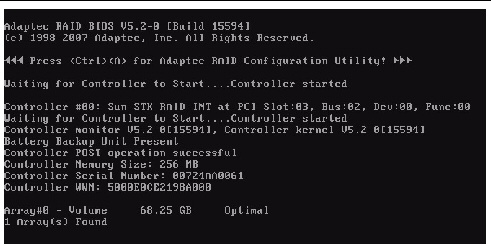
- For information about specific details of the operating system installation, refer to your Microsoft Windows documentation.
| Note - The complete Microsoft Windows operating system installation process is not documented in this section. This section documents only the steps that are specific for installing Windows Server 2003 on your server.
|
For requirements specific to the mass storage driver and Windows media delivery methods that you have chosen, see TABLE 6-1.
TABLE 6-1 Requirements for Each Installation Method
|
Method
|
Action or items required
|
|
Floppy Disk Local
|
Insert the mass-storage drivers floppy disk into a USB floppy drive attached directly to one of the server’s USB ports. Note that if you are using the floppy disk local installation method, the JavaRConsole floppy drive or floppy image devices must not be redirected.
|
|
Floppy Disk Remote
|
Connect the floppy drive to the JavaRConsole system (if necessary) and insert the mass-storage drivers floppy disk into the floppy drive.
|
|
Floppy Image
|
Ensure that the floppy.img file is accessible from the JavaRConsole system.
|
|
Windows Local
|
Make sure that the Microsoft Windows Server 2003 installation media and a DVD-ROM drive are available.
|
|
Windows Remote
|
Insert the Microsoft Windows Server 2003 installation media into the JavaRConsole system’s CD or DVD-ROM drive.
|
|
Windows Image
|
Ensure that the Windows Server 2003 installation media is accessible from the JavaRConsole system.
|
Installing the Operating System
Follow these steps to install the Microsoft Windows Server 2003 software onto your your server.
| Note - The Solaris Operating System may be preinstalled on your server’s boot disk. The Windows installation will format the boot disk and all data will be lost.
|
 To Install the Operating System To Install the Operating System
|
1. Make sure that you have completed all of the requirements listed in Installation Requirements.
2. Power cycle your server.
The BIOS POST process begins.
3. Press F8 when the Press F8 for BBS POPUP prompt appears on the BIOS POST screen (see FIGURE 6-2).
The BBS POPUP menu will allow you to select a boot device.
FIGURE 6-2 F8 Prompt Example

4. Once the BIOS POST process is complete, the Boot Device menu appears (see FIGURE 6-3). If you have selected the Windows Local installation method, insert the Windows media CD in the server’s CD/DVD drive now.
FIGURE 6-3 Boot Device Menu Example
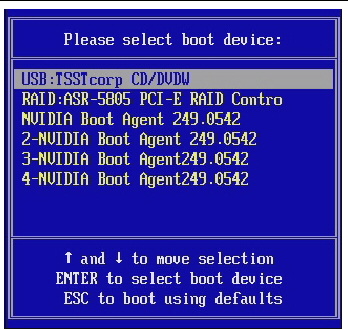
5. Select CD/DVDW from the Boot Device menu and press Enter.
If prompted with Press any key to boot from CD, quickly press any key.
The Windows Setup process begins.
6. Press F6 when you see the following prompt at the bottom of the screen during the Windows Setup process:
Press F6 if you need to install a third party SCSI or RAID driver.
| Note - The prompt is displayed in the early stages of Windows Setup and lasts for approximately five seconds and is easy to miss. If you do not press F6 while the prompt is being displayed, the screen allowing you to specify additional drivers is not displayed and the installation will fail. You will need to restart the system and go back to Step 3.
|
After pressing F6, a screen will appear providing you with the option to specify additional mass storage devices.
FIGURE 6-4 Specify Additional Device Screen
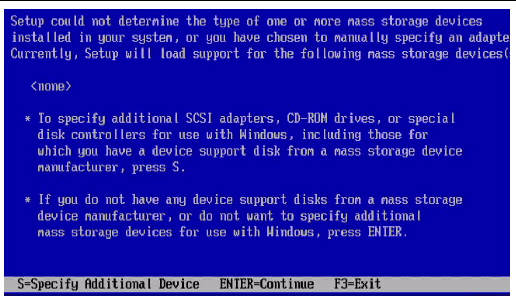
7. Make sure that the mass storage drivers are accessible according to the mass storage driver installation method that you have selected.
- Floppy Disk Local: Mass storage drivers floppy disk in floppy drive A on the server
- Floppy Disk Remote: Mass storage drivers floppy disk in the JavaRConsole server floppy drive
- Floppy Image: floppy.img available on the JavaRConsole system
8. Press S to specify additional devices.
A screen appears listing the available drivers.
FIGURE 6-5 Select Adapter Screen Example

9. Select the appropriate mass storage controller driver version depending on the version of Windows (32-bit or 64-bit) you are installing, and then press Enter:
- For servers with an LSI-based integrated RAID controller, select:
LSI Logic Fusion - MPT SAS Driver (32-bit)
or
LSI Logic Fusion - MPT SAS Driver (64-bit)
- For servers with an Adaptec-based integrated RAID controller, select:
SG-XPCIESAS-R SAS/SATA-II RAID Driver (32-bit)
or
SG-XPCIESAS-R SAS/SATA-II RAID Driver (64-bit)
- For servers with an NVIDIA-based integrated disk controller, select:
NVIDIA nForce Storage Controller (32-bit)
or
NVIDIA nForce Storage Controller (64-bit)
Windows Setup will then display your selection.
10. Windows Setup lists the driver to be installed. Press Enter to continue.
FIGURE 6-6 Specify Additional Devices Screen Example
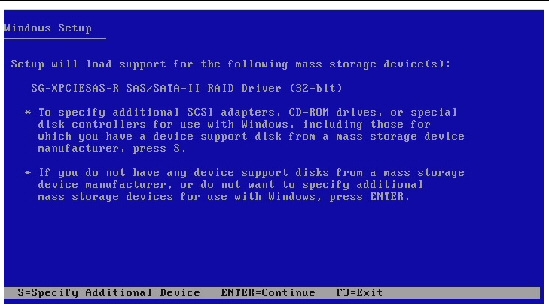
11. At the Welcome to Setup screen, press Enter to continue.
The Setup Selection screen is displayed.
12. Select a setup mode (Express or Custom) and continue.
If you created a RAID volume on your boot disk as part of your prerequisite preparations for installing Windows, press C to select Custom Setup and manually partition the disk. Make sure to reserve a minimum of 200 MB of unpartitioned space at the end of the drive. Otherwise, press Enter to select Express Setup.
FIGURE 6-7 Select Setup Screen
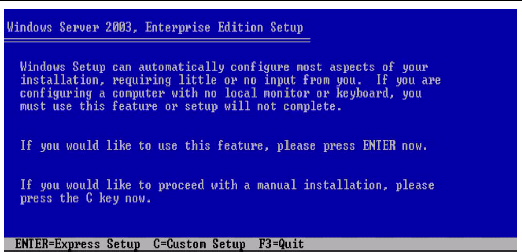
13. Follow the on-screen instructions to complete the initial setup of Windows Server 2003 until you are prompted with the following message:
Remove disks or other media. Press any key to restart.
When this message appears you will need to complete one of the following steps, depending on which driver delivery method you have chosen, to complete the installation:
- Floppy Disk Local: Remove the floppy disk from the floppy drive on the server.
- Floppy Disk Remote: Remove the floppy disk from the JavaRConsole server.
- Floppy Image: Deselect Floppy Image from the JavaRConsole Devices menu.
Then, press any key to restart the system and complete the Windows Server 2003 Installation.
14. Proceed to Chapter 8 “Updating the Critical Server-Specific Drivers.”
| Sun Fire X4140, X4240 and X4440 Servers Windows Operating System Installation Guide
|
820-2399-13
|
   
|
Copyright © 2009 Sun Microsystems, Inc. All rights reserved.






